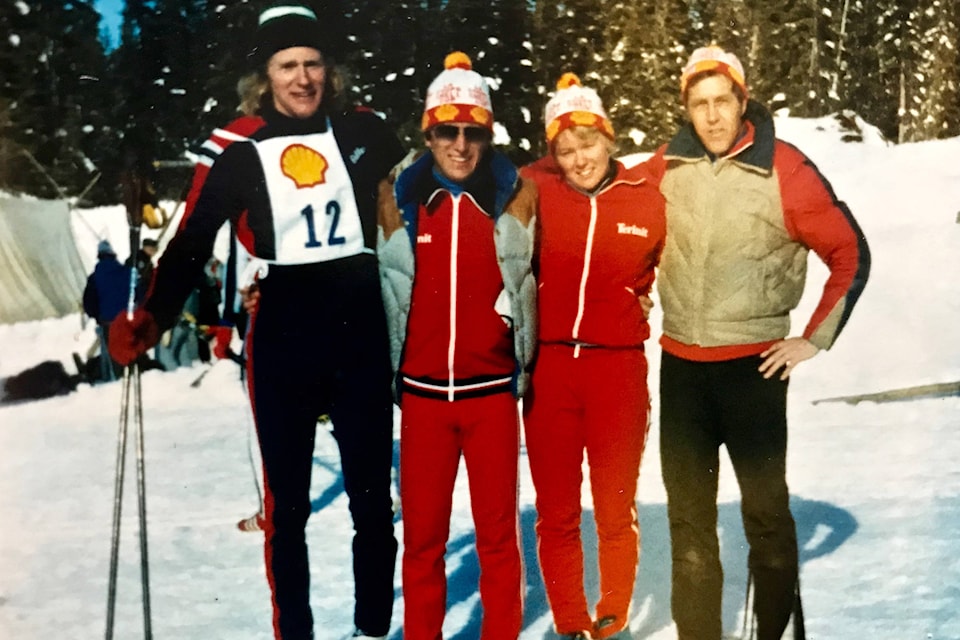Most Shuswap residents are within a one-hour drive away from one of two Nordic ski areas, Skmana Lake and the Larch Hills.
Although it is the smallest area with just 14 kilometres of track-set trails, Skmana includes hillside trails filled with dips and curves, a warming hut, a scenic trail that circles the two lakes and more recently, snowshoe trails.
Skmana Lake has a rich history, beginning with its likely use by the Secwepemc people for hunting, fishing and traditional food gathering. In the early 1900s, the Adams River Lumber Company diverted the creek and dammed the lake to use as a holding pond for logs that were sluiced down a massive flume to the Adams River below, then boomed and towed down the lakes to the mill in Chase. The very active Skmana Ski and Snowshoe Club was established in the early 1980s, and over the years raised funds for tracking equipment, along with holding fun family events and providing youth ski programs.
While Nordic skiing was a popular winter sport in the Shuswap, especially for Scandinavian immigrants during the settlement era, its popularity declined after the Second World War. Thanks to college instructors Tom Crowley and Connie Crowley, interest in the sport began to grow again in the early 1970s when they offered lessons to adults at local schools. In 1973, they joined with a group of avid cross-country skiers to form Shuswap Outdoors!, a club that continues to engage in year-round outdoor recreational activities.
Club members first skied at Mara Meadows where they discovered the many old logging roads and trails throughout the Larch Hills and realized these hills were ideal for an organized trail network.
After a few years of clearing the trails by hand, they formed a registered society in 1978, obtained a permit from the forest service office and received two Canada Works grants, which helped them design, clear and make the signs for 136 kilometres of trails.
Two lean-to shelters were built out of logs and more trails were added in succeeding years.
Read more: Shuswap Passion: How best to boost the local economy
Read more: Column: Celebrating 50 years of Shuswap Passion
Read more: Column: Home-based businesses thrive in the Shuswap
Shuswap Outdoors! members, Stig and Ruth Keskinen were keen skiers, a sport that Stig had excelled in as a youngster growing up in Finland.
One day Stig was asked to teach Erkki and Aira Keski-Salmi’s son Reino how to ski. Reino, who along with his parents were also Finnish immigrants, was ready to race within a year and they entered the Lake Louise Loppet.
A licence was needed to participate, which Reino acquired by joining the Revelstoke ski club.
As he did not want to keep racing as a Revelstoke skier, Reino suggested to Stig that they form a Salmon Arm club. While Ruth and Bev Walker took on the task of doing all the paperwork, Stig became the first president and, in 1980, the club was incorporated with just four families as members.
In the early days, practices and races were held on the level terrain at Dry Lake in Skimikin, which at first they tracked set using their skis. The club traveled to its first provincial race in 1979 where they did well and, in 1981, they won the trophy at Burns Lake.
The next step was to create a well-managed ski area in the Larch Hills. However, they faced resistance from the local forestry office which was concerned recreational use would restrict logging. Ruth and her team sprung into action, spending many days at a table in the mall signing up members and gathering petition signatures.
As a reporter and columnist for the Shopper’s Guide, Ruth was critical of the forest service’s opposition and the news made it to sympathetic politicians and staff in Victoria.
Once the local forest service reversed its position, progress came quickly. The first step was acquiring a groomer, and with a loan from Shuswap Outdoors! and grants, the Larch Hills Ski Club purchased a twin-track snowmobile and the forest service loaned them a tracksetter.
Trails were widened and, in 1982, the forest service built a new logging road to replace the steep, muddy one now used as an outrun trail. After many stakeholder meetings, in 1982 the Larch Hills was designated a 1,620-hectare winter recreation area. The following year, the original chalet was built by Duncan Morris, who supplied the logs, Dick Riach and other volunteers.
Today’s amazing success of the Larch Hills year-round recreational area is a result of the co-operation between self-propelled recreation enthusiasts, ski-racing devotees, and government land managers keen on sharing the resource. Reino Keski-Salmi, whose idea sparked the club’s creation and who became a North American ski champion, may have become an Olympic hero had he not tragically died in 1985 during a fire-fighting helicopter crash. The annual Reino Keski-Salmi Loppet, named after him in 1986, is now a premier event that attracts many hundreds of skiers.
